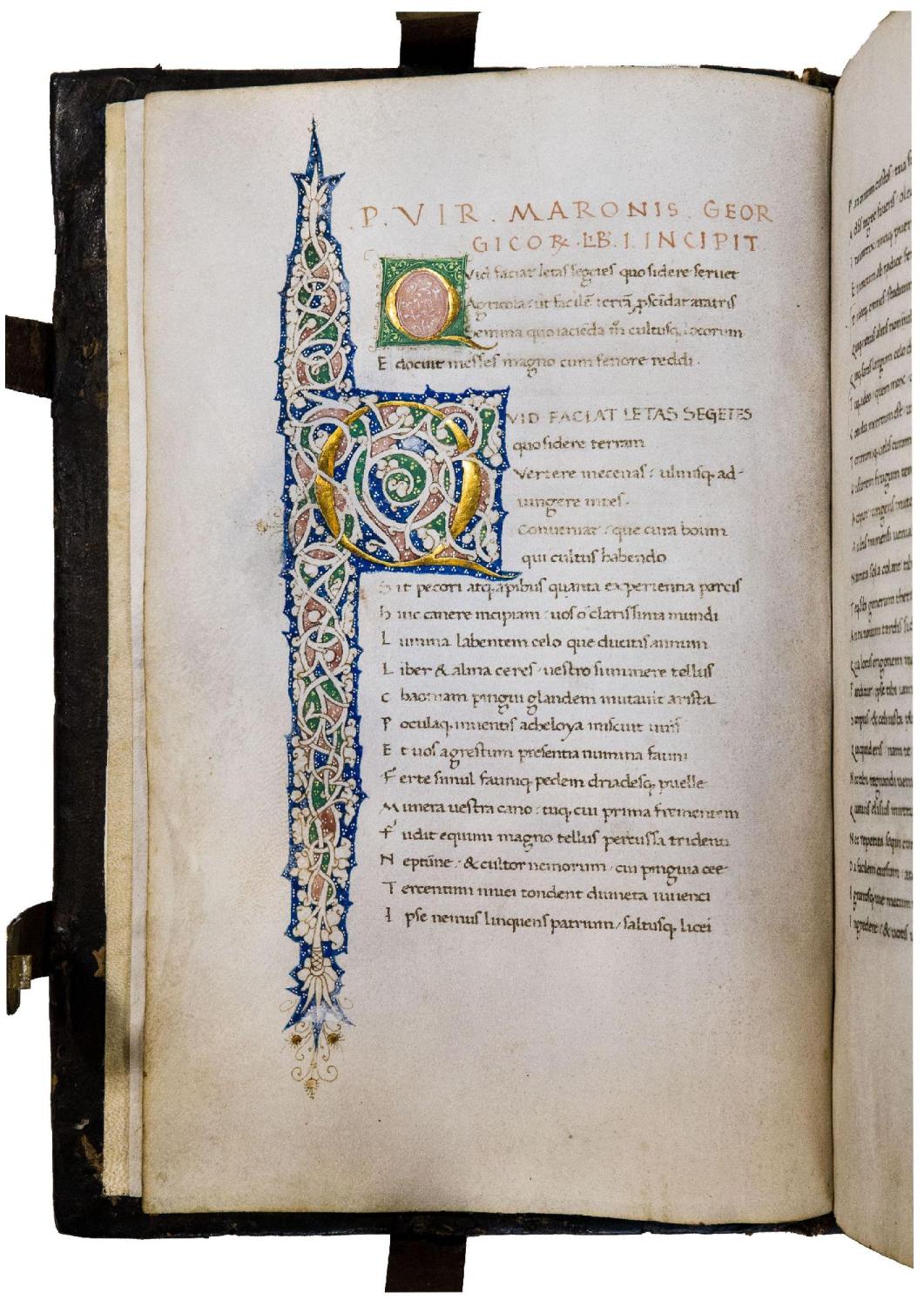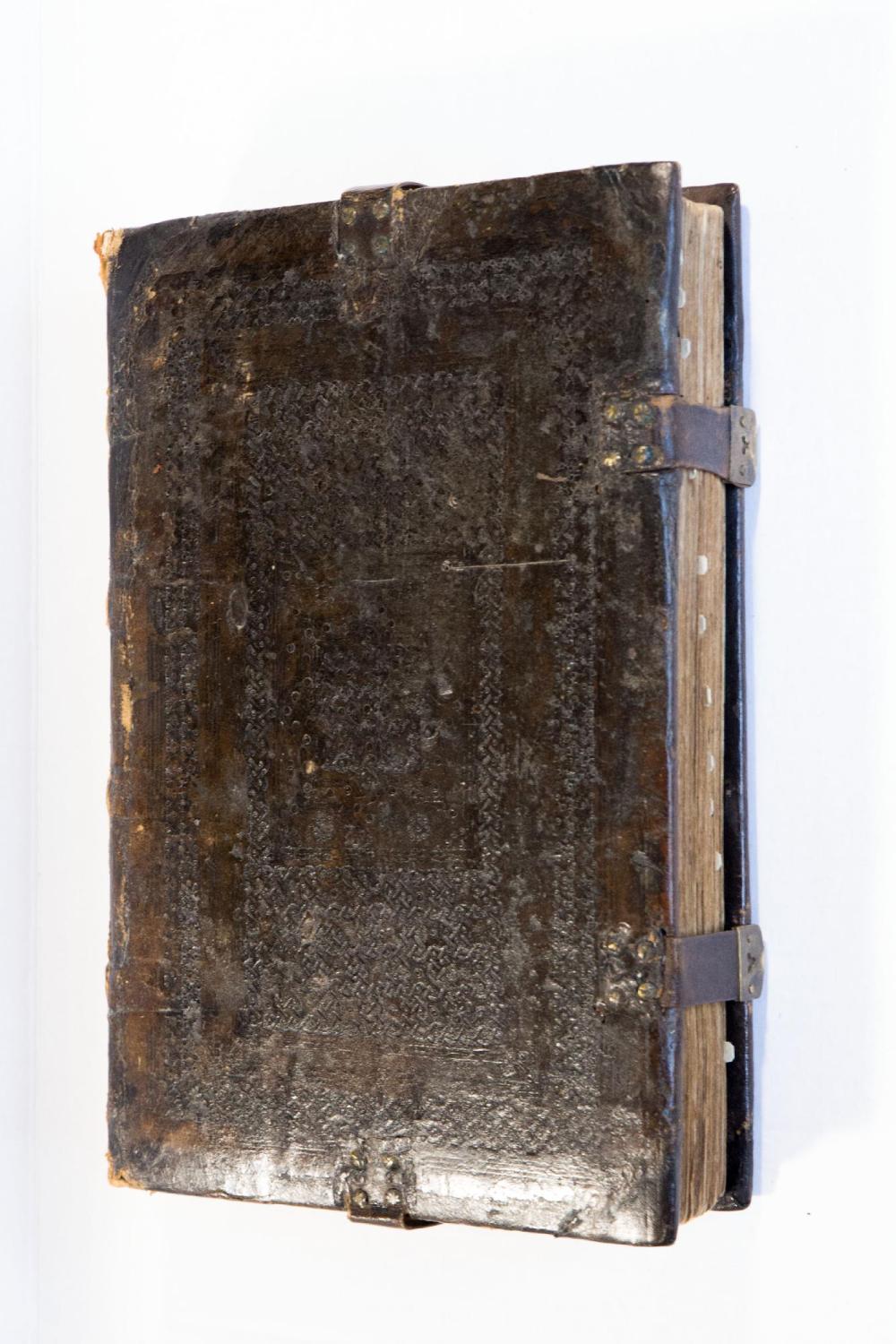Commentaire
Manuscrit passé à la vente en 2021. Prix annoncé : 204 552,68 euros
Description du libraire :
275x180 mm. i + 238 + ii leaves. Complete (with the replacement leaves, see below) but the volume evidently originally included at the beginning sixteen leaves with the Eclogues (an erasure on fol. 1r was probably the end of the Eclogues). Twenty-five quires (one quire of 10 leaves presumably lost). Collation: 110 (1-6 lost), 2-810, 910 (1-2 and 9 missing, replaced and numbered 74A, 74B, 80A), 10-2310, 248, 258 (most of 6, blank except for the colophon, cut away; 7-8 canc.). Blanks: 1r, 44v, 235v. Text block: 170x90 mm, one column, 26 lines. Ruled with dry point. Catchwords written vertically from top to bottom in the inner margin of the last page of each quire (a system of catchwords which the scribe Nicolaus Riccius used in his earliest manuscripts). Text written in brown ink in a formal humanist script, signed in the colophon on fol. 238r 'Nicolaus riccius spinosus vocatus scripsit'. At the beginning of each work titles in red capitals (fols. 1v, 45r). Fols. 74rA, 74B, 80A written in 1925 in a skilful imitation of Florentine humanist script by the English calligrapher William Graily Hewitt (1864-1952). On fols. 1v and 45r large gold and vinestem initials with small borders to the left, with clusters of gold-rayed discs and penwork at bottom; vinestem washed in yellow, grounds in brownish red, blue-green and darkish blue, dotted in white or yellow. Thirteen smaller gold initials on square panels of vinestem decoration, and (for the argumenta) fifteen three-line gold initials on blue, green and pink grounds patterned with white and yellow, and with curly outside edges in ink. On the replacement fol. 74A two initials – a vinestem initial and a smaller one on a blue and green ground – copied from the originals. Contemporary Florentine dark brown goatskin over wooden boards, panelled in blind with fillets and borders of small knotwork tools and roundels, star-shaped central panel of intersecting squares. Spine cross-hatched; four original metal clasps, leather straps replaced; edges with traces of gilding and gauffering. Some skilful repairs. In a modern slipcase. A fine, wide margined manuscript. Outer blank margin of fol. 18 cut away, the ink slightly rubbed on a few pages. Some cursive page headings, additions and corrections written by the scribe, a few notes in a later humanistic hand (e.g., fols. 3r, 54r, 54v, 89r). On fol. 70v the first line of the Helen episode 'Iamque adeo super unus eram, cum limina veste' (Aen., ii 567) was first written, then cancelled by the scribe with 'va-cat'.Text The manuscript contains the complete text (with the replacement leaves, see above) of Virgil's Georgica, and Aeneis. The volume evidently originally included at the beginning sixteen leaves with the Eclogues (an erasure on fol. 1r was probably the end of the Eclogues): fols. 1v-44r: Vergilius, Georgicorum Libri; inc.: 'Quid faciat letas'; fols. 45r-234v: Vergilius, Aeneidos Liber; inc.: 'Arma virumque cano'. Provenance: Leo S. Olschki (1861-1940; Le livre en Italie à travers les siècles, Firenze 1914, no. 108; "Ce Manuscrit est écrit sur beau vélin blanc à très grandes marges. Le dernier f. ne contient que ces lignes: "Liber uirgilii eneidum explicit Nicolaus riccius spinosus uocatus scripsit [.] la marge blanche au-dessous de ces 2 lignes surnommés a été decoupée"); Tammaro De Marinis (1878-1969; see the sale of his collection by Hoepli, Vendita all'asta della preziosa collezione proveniente dalla cessata Libreria De Marinis, Milano 1925, no. 211, pl. xliv, "Magnifico codice fiorentino"); Sir Sidney Carlyle Cockerell (1867-1962; bought for 30,000 lire; in his hand the note dated 27 June 1925, regarding the scribe and the replacement leaves written for him by Graily Hewitt); Charles Harold St John Hornby (1867 1946); John Roland Abbey (1896-1969; ex-libris dated 1933; Sotheby's, Catalogue of the Celebrated Library of the late Major J. R. Abbey. The Eighth Portion: The Hornby Manuscripts, Part i, London 1974, lot 2930, and pl. N° de réf. du libraire 0000000007965




